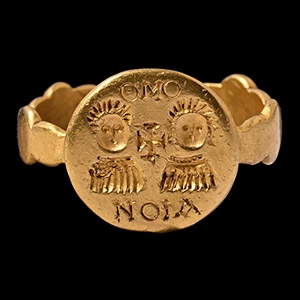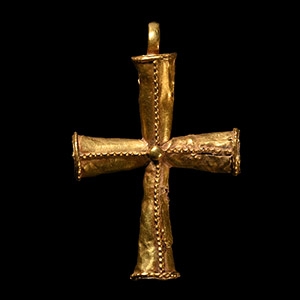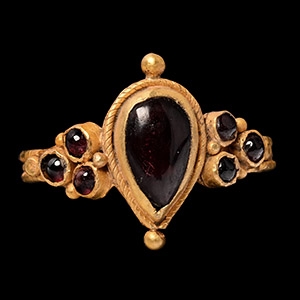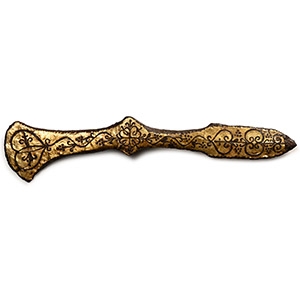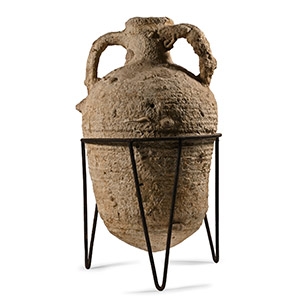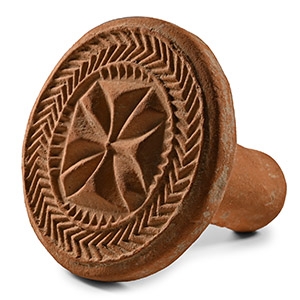Home > Auctions > 26 November - 1 December 2024
Ancient Art, Antiquities, Natural History & Coins
From a collection acquired on the UK art market from various auction houses and collections mostly before 2000.
From an important Cambridgeshire estate; thence by descent.
Cf. Rolland, H., Bronzes Antiques de Haute Provence, Paris, 1965, items 85, 89, for type.
Exhibited at the Harwich Museum, Harwich, Essex, UK, 11th September-2nd December 2024; accompanied by a copy of a photograph of the artefacts on display.
The execution is far from naturalistic and was probably produced in a provincial workshop, possibly in Gaul or southern Britain.
From a collection acquired on the UK art market from various auction houses and collections mostly before 2000.
From an important Cambridgeshire estate; thence by descent.
Cf. Rolland, H., Bronzes Antiques de Haute Provence, Paris, 1965, item 38, for type.
Despite the lack of specific attributes related to Hermes, the pose of the statue, with the right hand advanced to hold the sacculus, the cloak thrown over the right shoulder and then folded over the left would lean towards an interpretation of the statuette as an ex voto related to the god of thieves. The statuette seems to originate from a Gallo-Roman workshop. A similar drapery on the chest is also found on a Mercury/Hermes in the Museum of Besancon.
From a private UK collection, since at least 1971.
Acquired from Rupert Wace Ancient Art Limited, Old Bond Street, London W1, UK, in 2001.
From the private collection of Mr M.R. Davis, Bristol, UK.
Accompanied by a copy of a stamped and signed Art Loss Register declaration dated 1st March 2001.
Accompanied by a copy of a conservation report by restorer David Singleton dated 26th June 2001.
Accompanied by a copy of the 23th February 2001 invoice (£34,000); a copy of the illustrated listing with reference number C230; plus communications regarding acquisition.
Accompanied by an academic report by Dr Raffaele D’Amato.
This lot has been checked against the Interpol Database of stolen works of art and is accompanied by search certificate no.12339-224541.
Cf. Michalowski, K., Palmyre, Fouilles Polonaises, 1960, Warszawa-Paris, 1962, fig.192; Muzeum Narodowe w Warszawie, Sztuka Palmyry (Art of Palmyra), Warszawa, 1986, pls.10,23; Fortin, M., Syrie, terre de civilisations, Québec, 1999, figs.336-337; Gabucci, A. (ed.), Zenobia, il sogno di una regina d'oriente, Milano, 2002, no.25 (for the typology of the portrait).
The sculpture is a good example of 2nd-3rd century A.D. Palmyrene female funerary portrait types. The amount of jewellery displayed in these portraits could be a direct reflection of the wealth of the family, and certainly reflected the jewellery possessed by the owner of the grave.
Previously in the private collection of Mr Pierre Bart (1889-1964), an official of the French Mandate in Syria and Lebanon (1919-1936), and delegate to the Lebanese government until 1946.
Thence by descent in 1964 to his daughter Lucienne Amirault who brought the inherited collection with her to France from Beirut on 11th October 1976.
Accompanied by inventory list from 11 October 1976.
Accompanied by a copy of a previous six page catalogue document.
Accompanied by a copy of a signed Art Loss Register declaration no.S00218486.
Accompanied by French cultural passport no.233598.
This lot has been checked against the Interpol Database of stolen works of art and is accompanied by a search certificate number no.12399-225440.
Cf. similar item in the British Museum under accession no. 1889,1012.8; Michalowski, K., Palmyre, Fouilles Polonaises, 1960, Warszawa-Paris, 1962, fig.192, for type.
Mobilier d’un Appartement Parisien, Chayette & Cheval, Paris, 28 January 2022, no. 128.
Private collection, Europe.
Acquired by the current owner in 1999.
Accompanied by a copy of an Art Loss Register certificate no.S00038155.
Cf. the Metropolitan Museum of Art, New York under accession number 67.154.1, for similar.
The choice of the image of the empress for an official weight may have been to display fairness and equality before the law in commercial matters, as well as to bolster the authority of the imperial family.
Acquired on the London art market in the late 1980s-1990s.
From the family collection of an East London, UK, gentleman.
This lot has been checked against the Interpol Database of stolen works of art and is accompanied by a search certificate no.12350-222584
Cf. similar subject in a ring of Museum of Fine Arts, Boston, accessory no.63.1555; see also The Museum of Fine Arts, Boston, Romans and Barbarians, Boston, 1976, p.179, no.202.
The marriage ring is one of the typologies on which figural decorations are frequently found. Generally marriage rings are engraved with a representation of the husband and wife, sometimes accompanied by Christ, and usually engraved with wishes for 'harmony, health and the grace of God'. Rings of this type had been used since the late 4th century A.D. and remained extremely popular in Byzantium in the 6th and 7th century.
Formerly in North American collection, 1990s.
From the collection of a London, UK, gentleman.
Acquired in the mid 1980s-1990s.
From the family collection of Mr S.A., Switzerland, thence by descent.
Private collection since the late 1990s.
This lot has been checked against the Interpol Database of stolen works of art and is accompanied by a search certificate number no.12114-218167.
Cf. Wamser, L., Die Welt von Byzanz - Europas Östliches Erbe, München, 2004, item 519, for type.
Acquired on the London art market in the late 1980s-1990s.
From the family collection of an East London, UK, gentleman.
Cf. Wamser, L., Die Welt von Byzanz - Europas Östliches Erbe, München, 2004, item 690, for type.
Private collection formed in Europe in the 1980s.
Westminster collection, central London, UK.
Accompanied by an academic report by Dr Raffaele D’Amato.
This lot has been checked against the Interpol Database of stolen works of art and is accompanied by search certificate no. no.12340-225024.
See similar forms (iconography) in Nicolle, Arms and Armour of the Crusading Era, 1050-1350 AD, volume II, Islam, Eastern Europe and Asia, London, 1999, figs.33p &118c, pp.355 and 373; for battle specimens from the territories of Eastern Roman Empire cf. Yotov, V., Въоръжението и снаряжението от българското средновековие (VII-XI век), (Arms in Bulgaria in medieval period, 7th – 12th century), Варна 2004, no.637; Gorelik, M., ‘Arms and Armour in South-Eastern Europe in the Second Half of First Millennium AD’ in Nicolle, D. (ed.), A Companion to Medieval Arms and Armour, Oxford, 2002, pp.127-148, pl.XL-8, nos.33 ,34 (Khazar Khanate equipment).
It is possible that this axe was used as a status symbol for officers or their family. The axe was known to be a symbol of the Varangian Guard who protected the emperor.
From a family collection mostly formed in the 1940s-1950s, thence by descent.
From the collection of Sir Daniel Donohue [1919-2014] and the Countess Bernardine [1904-1968], Los Angeles, USA; the collection was assembled in the 1950-1960s, but before March 1968.
with Bonhams, London, 13 April 2011, no.310 [Part].
Acquired on the English art market, 2011.
Private collection, Europe.
Accompanied by copies of the relevant Bonhams catalogue pages.
121 - 132 of 3419 LOTS

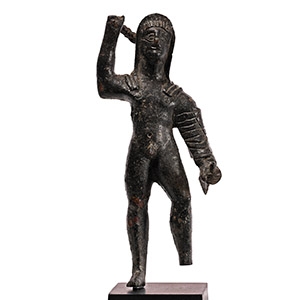
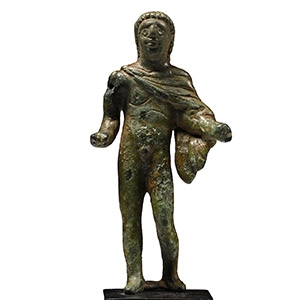
.jpg)
.jpg)

